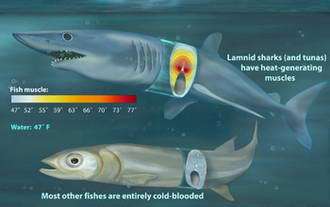How Hot Tuna (and Some Sharks) Stay Warm

Scientists now have direct evidence that the north Pacific salmon shark maintains its red muscle (RM) at 68-86 degrees Fahrenheit, much warmer than the 47 F water in which it lives. The elevated muscle temperature presumably helps the salmon shark survive the cold waters of the north Pacific and take advantage of the abundant food supply there. The heat also appears to factor into the fish's impressive swimming ability.
Image: Lamnid sharks maintain an elevated temperature in the red muscle concentrated in their mid-region near the backbone. This specialized anatomy allows the predators to swim fast and continuously, which in turn, allows heat to be retained in the core of the fish leading to local warm-bloodedness. In most other fish, the red muscle is located close to the skin, yielding a fully cold-blooded body and only short bursts of rapid, powerful swimming. Credit: Zina Deretsky, National Science Foundation
During what some would say was a better-than-average day at work, Robert Shadwick of the Scripps Institution of Oceanography and his colleagues went salmon shark fishing in the Gulf of Alaska. After catching specimens over 7-feet long and weighing more than 300 pounds, the researchers measured temperatures throughout the sharks' bodies and tested the mechanical power of RM samples.
Their results, published in the Oct. 27 issue of the journal Nature, showed that at 50 F, RM produced only 25-50 percent of the power it produced at 79 F. The researchers concluded that RM temperatures below 68 F could permanently impair muscle function.
National Science Foundation (NSF) program manager, Ione Hunt von Herbing said, "Knowing specific details about the anatomy and physiology of salmon sharks provides key insight into their ability to produce such power and speed during swimming. The knowledge could translate into better designs for underwater vehicles."
The study was funded by NSF's integrative organismal biology program.
Salmon sharks are lamnids, a group of sharks that also includes the mako and great white. Numerous studies have shown that lamnid sharks and tunas share many anatomical and physiological specializations that endow them with their impressive swimming power and speed. In contrast to other fish where the RM is near the skin, the RM of these sharks and tunas is near the backbone. Even though the ancestors of bony tuna and cartilaginous sharks diverged more than 400 million years ago, selection pressure for high-performance swimming in each group seems to have occurred independently about 50 million years ago.
Throughout its life, a salmon shark never stops swimming because it will sink. The body heat generated from continuous swimming elevates the RM temperature, which in turn, warms the surrounding white muscle and allows the shark to survive the frigid waters of the north Pacific. If a shark stops swimming, it could die from cold exposure.
Source: NSF















